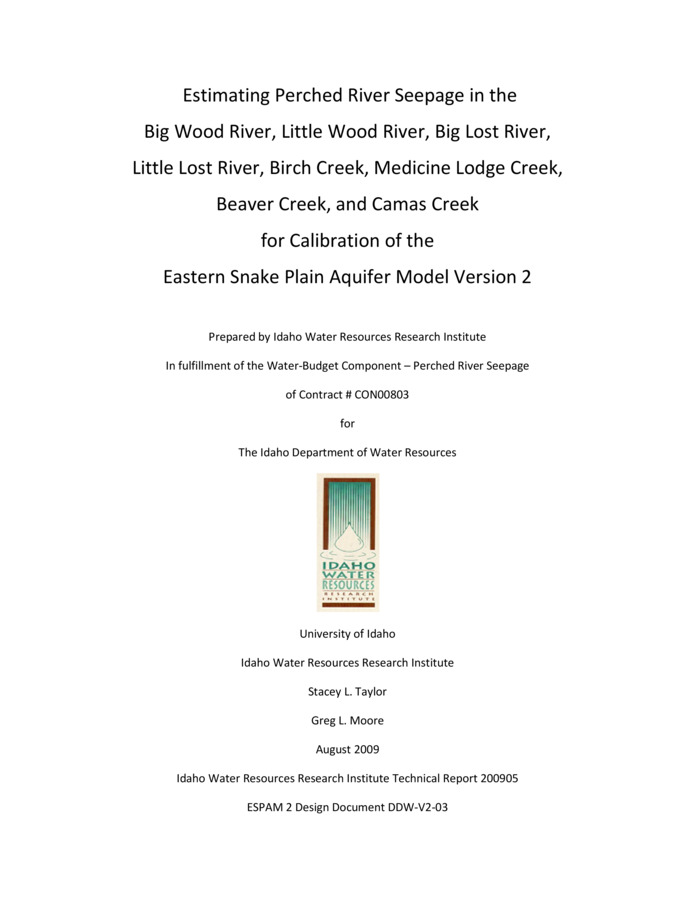PDF
Estimating perched river seepage in the Big Wood River, Little Wood River, Big Lost River, Little Lost River, Birch Creek, Medicine Lodge Creek, Beaver Creek, and Camas Creek for calibration of the Eastern Snake Plain Aquifer Model Version 2. Draft. Technical report 200905. ESPAM 2 design document DDW-V2-03 Item Info
- Title:
- Estimating perched river seepage in the Big Wood River, Little Wood River, Big Lost River, Little Lost River, Birch Creek, Medicine Lodge Creek, Beaver Creek, and Camas Creek for calibration of the Eastern Snake Plain Aquifer Model Version 2. Draft. Technical report 200905. ESPAM 2 design document DDW-V2-03
- Authors:
- Taylor, Stacey L.; Moore, Greg L.
- Date:
- 2009-08
- Description:
- This report is a Design Document for the calibration of the Eastern Snake Plain Aquifer Model Version 2 (ESPAM 2). Its goals are similar to the goals of Design Documents for ESPAM 1.1: To provide full transparency of modeling data, decisions and calibration; and to seek input from representatives of various stakeholders so that the resulting product can be the best possible technical representation of the physical system (given constraints of time, funding and personnel). It is anticipated that for some topics, a single Design Document will serve these purposes prior to issuance of a final report. For other topics, a draft document will be followed by one or more revisions and a final "as-built" Design Document. Superseded Design Documents will be maintained in a "superseded" file folder on the project Website, and successive versions will be maintained in a "current" folder. This will provide additional documentation of project history and the development of ideas. As discussed in analysis for ESPAM 1.1, Design Document DDW-024 (Erickson, Nelson, and Contor, 2004) some streams in the Snake River Plain that are perched are believed to be hydraulically contributing to the aquifer because of seepage. This design document describes perched river seepage from streams and other water bodies in the Eastern Snake Plain. Some surface water bodies that are represented in ESPAM 1.1 as perched are likely connected to the aquifer, which includes Mud Lake and parts of the Big Lost River and Camas Creek. These were not represented as hydraulically connected because simulating impacts to those water bodies was not part of the purpose of ESPAM 1.1. Because these are tributary to the regional aquifer, this doesn't change the water balance nor does it materially change the propagation of impacts to the Snake River or springs. These water bodies (Mud Lake, parts of the Big Lost River and Camas Creek, part of Twin Falls Canal, and Lake Murtaugh) will be simulated the same as they are in ESPAM 1.1 and will therefore not be discussed in this design document. Seepage from the Snake River is excluded from this discussion as it is simulated with the River Package as discussed in DDM-03 (Taylor and Moore, 2009).
- Subjects:
- aquifers groundwater computer models
- Location:
- Big Wood River; Little Wood River; Big Lost River; Little Lost River; Birch Creek; Medicine Lodge Creek; Beaver Creek; Camas Creek; Southern Idaho
- Idaho County:
- Gooding County; Blaine County; Camas County; Lincoln County
- Latitude:
- 42.94
- Longitude:
- -114.79
- Collection:
- Boise Basin
- Series:
- ESPAM2
- Source:
- Idaho Water Resources Research Institute, University of Idaho
- Identifier:
- IWRRI Number 200905
- Publisher:
- Idaho Water Resources Research Institute, University of Idaho
- Contributing Institution:
- University of Idaho
- Type:
- Text
- Format:
- application/pdf
- Cataloger:
- KIT
- Language:
- eng
Source
- Preferred Citation:
- "Estimating perched river seepage in the Big Wood River, Little Wood River, Big Lost River, Little Lost River, Birch Creek, Medicine Lodge Creek, Beaver Creek, and Camas Creek for calibration of the Eastern Snake Plain Aquifer Model Version 2. Draft. Technical report 200905. ESPAM 2 design document DDW-V2-03", Idaho Waters Digital Library, University of Idaho Library Digital Collections, https://www.lib.uidaho.edu/digital/iwdl/items/iwdl-200905.html
Rights
- Rights:
- In copyright, educational use permitted. Educational use includes non-commercial reproduction of text and images in materials for teaching and research purposes. For other contexts beyond fair use, including digital reproduction, please contact the University of Idaho Library Special Collections and Archives Department at libspec@uidaho.edu. The University of Idaho Library is not liable for any violations of the law by users.
- Standardized Rights:
- http://rightsstatements.org/vocab/InC-EDU/1.0/

